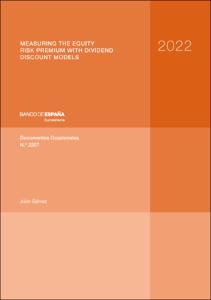Measuring the equity risk premium with dividend discount models
Autor
Fecha de publicación
2-jun-2022
Descripción física
28 p.
Resumen
Este trabajo evalúa la estimación de la prima de riesgo de la renta variable, es decir, el rendimiento esperado de la renta variable por encima del tipo libre de riesgo, utilizando el modelo de descuento de dividendos como marco organizativo. Comparo las estimaciones de la prima de riesgo de la renta variable a partir de diferentes modelos de descuento de dividendos en términos de la capacidad de previsión dentro y fuera de la muestra a través de diferentes horizontes temporales. Utilizando datos del EURO STOXX 50 de entre 2001 y 2021, encuentro que las estimaciones de la prima de riesgo de la renta variable muestran una dinámica similar, y son elevadas durante los períodos de alta incertidumbre, como el inicio de la pandemia de COVID-19. Además, encuentro que el modelo de descuento de dividendos en tres etapas, que divide el crecimiento de los beneficios en una fase extraordinaria, otra de transición y otra de estado estable, es el que mejor funciona en términos de capacidad de previsión.
This paper assesses the estimation of the so-called equity risk premium, i.e. the expected return on equities in excess of the risk-free rate, using the dividend discount model as the organizing framework. I compare the equity risk premium estimates from different dividend discount models in terms of the in-sample and out-of-sample forecasting ability across different time horizons. Using data from the Eurostoxx 50 from 2001-2021, I find that equity risk premium estimates exhibit similar dynamics, and are elevated during periods of high uncertainty, such as the onset of the COVID-19 pandemic. Moreover, I find that the three-stage dividend discount model, which divides earnings growth into an extraordinary, transitional and steady-state phase, performs the best in terms of forecasting ability.
This paper assesses the estimation of the so-called equity risk premium, i.e. the expected return on equities in excess of the risk-free rate, using the dividend discount model as the organizing framework. I compare the equity risk premium estimates from different dividend discount models in terms of the in-sample and out-of-sample forecasting ability across different time horizons. Using data from the Eurostoxx 50 from 2001-2021, I find that equity risk premium estimates exhibit similar dynamics, and are elevated during periods of high uncertainty, such as the onset of the COVID-19 pandemic. Moreover, I find that the three-stage dividend discount model, which divides earnings growth into an extraordinary, transitional and steady-state phase, performs the best in terms of forecasting ability.
Publicado en
Documentos Ocasionales / Banco de España, 2207
Materias
Rentabilidad esperada; Prima de riesgo de la renta variable; Modelo de descuento de dividendos; Previsibilidad de la rentabilidad; Expected returns; Equity risk premium; Dividend discount model; Return predictability; Operaciones y política bancaria; Valoración de activos; Finanzas internacionales
Aparece en las colecciones:












